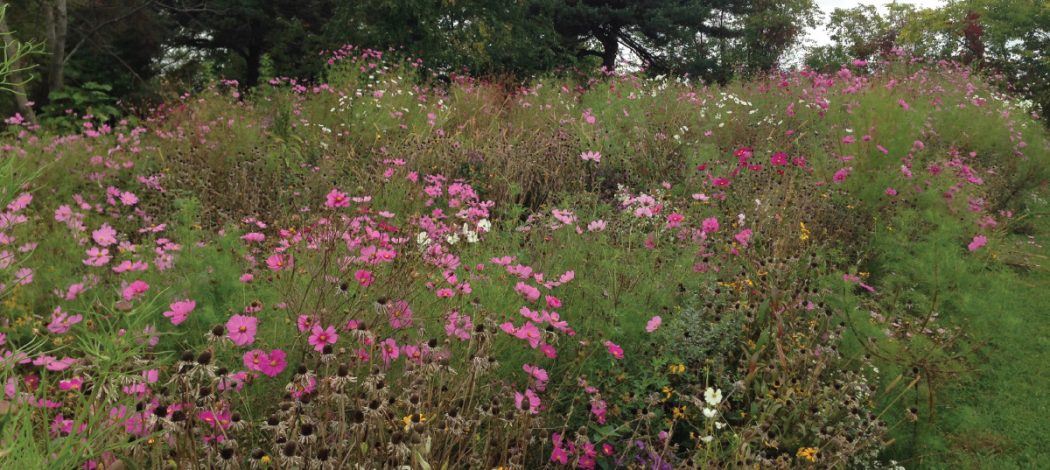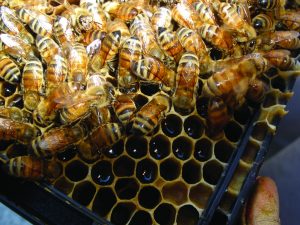By: Rachael Bonoan
Can we help pollinators help themselves?
Pollinators Can Get Medicine from Their Food
While there are plenty of activist groups raising money to help pollinators, there may be something we’re missing, something simple that we can do to help pollinators help themselves. Recent research shows that pollinators are able to naturally medicate themselves by using certain plant chemicals – termed secondary compounds – that are found in their main food source: pollen and nectar. If we learn about how pollinators naturally medicate themselves using secondary compounds, we might be able to naturally mitigate their decline.
The use of plant secondary compounds by animals is not new knowledge – caffeine is a secondary compound that we are all familiar with. Though caffeine is toxic to most leaf-eating insects, many other animals (including humans) use caffeine to their benefit. According to Ethiopian legend, the energizing effect of caffeine was discovered by a goat herder named Kaldi. One day, while Kaldi watched his goats, he noticed that after they ate berries from a particular shrub, they became uncharacteristically energetic, frolicking wildly through the pasture. Kaldi tried the berries for himself and found a similar energizing effect; he spread the word and shared the berries with some monks in the area – the monks spent the night awake and alert. Today, we know that in addition to eating plant parts with secondary compounds for energy, many animals eat plant parts when they are sick – this is called self-medication.
Most medicines, whether it be for humans or for butterflies, are derived from secondary compounds. For example, the main ingredient in aspirin comes from willow trees. Secondary compounds are plant chemicals that are not used for growth or reproduction but rather for defense against leaf-eating insects. Leaves have high concentrations of secondary compounds which are toxic to many insects. In contrast, pollen and nectar – the main food sources for pollinators – have low concentrations of these compounds which are toxic to only the microbes that infect pollinators, not the pollinators themselves. Thus, pollinators may benefit from eating certain secondary compounds that are found in pollen and nectar. “Secondary compounds are present in nectar as an unavoidable consequence of plants protecting themselves against herbivores” explains Dr. Leif Richardson, a research fellow at the University of Vermont.
Therapeutic & Preventative Self-medication in Pollinators
There are four types of self-medication that animals use. The simplest types, preventative and therapeutic, consist of the animal directly medicating itself. For example, as a preventative measure, if you know you have allergies and the pollen count is high, you might take an allergy pill before going outside. Therapeutic self-medication is defined as taking medicine once you already have symptoms: you may have forgotten to take that allergy pill before you left the house, so you take aspirin once you get a headache. Preventative self-medication was found in monarch butterflies in the 1980s and more recently, therapeutic self-medication has been found in both bumble bees [1] and honey bees [2].
Monarch butterflies lay their eggs on milkweed plants, but out of the 108 milkweed species found in North America, monarchs only lay their eggs on 27 of those plants. Research in the 1980s by Stephen B. Malcolm and Lincoln P. Brower showed that compared to the other 81 milkweed plants, the 27 plants that monarchs lay their eggs on have much higher concentrations of a certain secondary compound which has detrimental effects on a common monarch disease. Thus, it is likely that monarchs lay their eggs on these specific 27 plants in order to preventatively protect their offspring.
Examples of therapeutic self-medication are found in both bumble bees and honey bees. Bumble bees infected with a common fungal disease, and then fed a sugar solution infused with a secondary compound, ended up with lower parasite loads compared to infected bumble bees fed a plain sugar solution. Moreover, “when you give choices in the lab, infected bees will eat more of the chemical that drives down their parasites.” states Dr. Richardson. Similar results were found in honey bees by Dr. Silvio Erler, a molecular ecologist at Martin Luther University in Halle, Germany.
“We show that [honey] bees can in some way self-medicate by selective consumption of honey.” explains Dr. Erler. In Dr. Erler’s study, honey bees infected with a common fungal disease were given a choice of various honeys: sunflower honey, linden tree honey, black locust honey, or honeydew. Overall, sick bees preferred sunflower honey. When the different honeys were tested for antimicrobial activity, the sunflower honey killed the most microbes, as expected. Somehow, infected honey bees knew which honey would help their infection. Based on Dr. Erler and Dr. Richardson’s work, it is likely that pollinators know what they need to heal themselves.
Trans-generational & Social Self-medication in Pollinators
The last two types of self-medication, trans-generational and social, are self-medication where the animal is helping its family and therefore ensuring its relatives survive. Ensuring the survival of your relatives is important – you share the same genes. Helping your relatives helps your genes persist in the population. Monarch butterflies medicate their offspring – trans-generational medication – and social bees likely medicate their neighbors in the hive – social self-medication.
When monarch butterflies pass on medicinal compounds to their children, it’s the father that is important. Humans, however, passively achieve trans-generational self-medication via the mother. When a mother breastfeeds her child, she is passing on antibodies that her body has made over the years. To examine this effect in monarch butterflies, Dr. Eleanore Sternberg, a postdoctoral fellow at Penn State University, and her colleagues raised monarch caterpillars on one of two plants: “medicinal” milkweed with high concentrations of secondary compounds, or “non-medicinal” milkweed with low concentrations of secondary compounds [3].
Once the caterpillars became adult butterflies, Dr. Sternberg and colleagues mated males and females that were raised on the different types of milkweed. Following matings, the eggs were infected with a parasite that commonly targets both monarch caterpillars and butterflies. No matter the diet of the mother, the eggs that had a father raised on the medicinal milkweed were more resistant to infection than eggs from a father raised on the non-medicinal milkweed. Dr. Sternberg explains “the most interesting aspect is the fact that we do find a paternal effect. There’s been quite a bit of interest in what mothers can provide to their offspring in terms of protection from parasites but much less is known about what fathers can provide.”
As a social insect scientist myself, I find the fourth form of self-medication, social self-medication, the most exciting. But, it is also the most complex. Social self-medication consists of giving medicine to the people you live with. For example, if your sibling has the flu, you may give him or her medicine. Not only does this benefit you – if your sibling gets better quicker, your sibling will survive, and you might not get sick – but it benefits the rest of your family too: they might not get sick either.
Social self-medication has yet to be found in pollinators but given that bumble bees and honey bees are highly social insects, it is likely that both medicate their young, and neighbors, in the hive. Discussing his research on bumble bee self-medication, Dr. Richardson explains “The really interesting aspect is that [bumble] bees are social, and the workers are feeding the queen and larvae, sometimes the males.” In both bumble bees and honey bees, the adult workers take care of their younger siblings (larvae) by bringing food back to the hive and feeding the young. The adult workers also take care of their queen bee, the only female in the colony that lays fertilized eggs, and sometimes their older brothers. Since the workers are the ones choosing which food to bring back to the hive, it is possible that upon an infection of their younger siblings, or the queen, the workers would find the right medicinal food to feed them.
Hence, social medication could reasonably occur in bumble bees and honey bees, but social self-medication is not easy to study; Dr. Erler explains that running hive-level experiments means “we have the environment as a factor including climate, humidity, rain, wind, we have the availability of different food sources, which varies much over the seasons, and we have many more different individuals of different ages.” Although difficult to study, it is important to study social self-medication in pollinators – in our fight against pollinator decline, it is much more powerful to keep a whole hive healthy rather than only one individual.
So, what can we do to help?
The answer is simple: plant lots of flowers. Monarch butterflies know which plant to lay their eggs on, and bumble bees and honey bees know which flowers to visit when they are feeling under the weather. But, in order to let pollinators get the medicine they need, we have to provide them with choices.
Just as monarch butterflies choose which plants to lay their eggs on, bumble bees also make choices in the field. In nature, “when a [bumble] bee is infected, it forages longer, and on flowers with high concentrations of these [secondary] compounds rather than flowers with low concentrations.” explains Dr. Richardson. Thus, sick bumble bees are making a choice – based on their health – to seek out the best quality medicine.
While aspirin might work for your headache, it will not work for your runny nose; when you walk into a drugstore, you have your choice of which medicine to take. This may also be true for pollinators; sunflower honey worked well against a particular fungal infection in honey bees but a different type of infection may require a different type of medication. Regarding honey bees, Dr. Erler explains that “they should live in natural environments with a high diversity of plants” so that they have access to diverse types of medicines. The same is true for both monarch butterflies and bumble bees.
While there is still more to learn about self-medication in pollinators, when it comes to self-medication, the more choices you have, the more likely you are to find what works. Many beekeepers medicate their honey bee hives with expensive chemicals and man-made compounds but it is likely more productive, and definitely less expensive, to simply plant more flowers and let the pollinators make the best choices to naturally medicate themselves.
- Richardson, L.L., et al., Secondary metabolites in floral nectar reduce parasite infections in bumblebees. Proceeding of the Royal Society 2015. 282(1803).
- Gherman, B.I., et al., Pathogen-associated self-medication behavior in the honeybee Apis mellifera. Behavioral Ecology and Sociobiology, 2014. 68(11): p. 1777-1784.
- Sternberg, E.D., J.C. de Roode, and M.D. Hunter, Trans-generational parasite protection associated with paternal diet. Journal of Animal Ecology, 2015. 84(1): p. 310-321.








